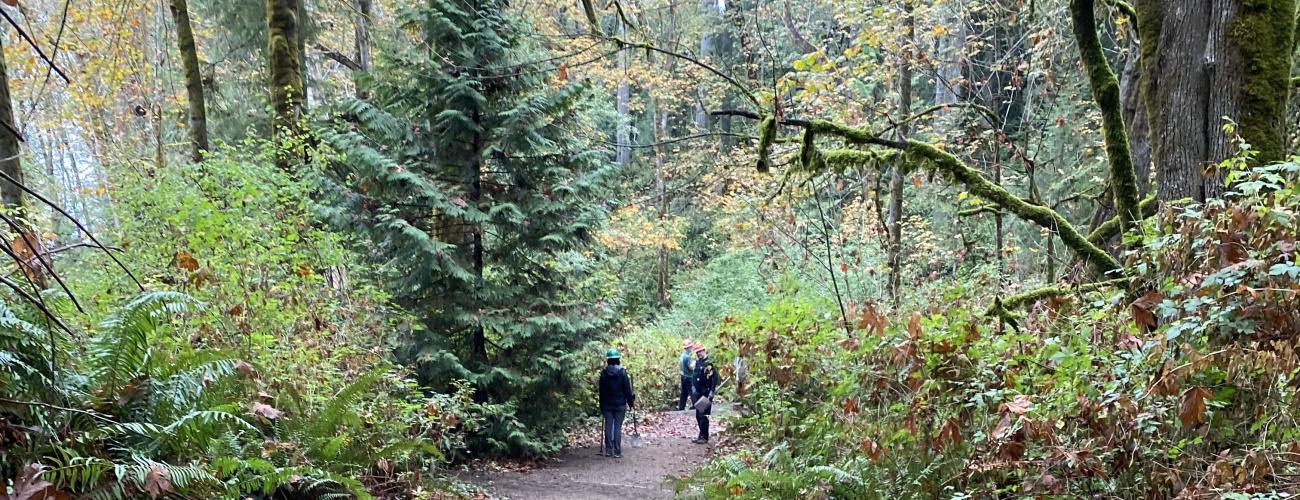Kopachuck State Park History
Kopachuck State Park is a good place to contemplate the many interconnections that bind the community of life to the landscape we all inhabit.
The winding saltwater passageways of southern Puget Sound, including Carr Inlet surrounding Kopachuck State Park, were molded and scoured by glacial meltwaters at the close of the Pleistocene ice age.
Indigenous Land
Kopachuck State Park lies within the traditional territory of Coast Salish Indigenous people whose present-day descendants include members of the Squaxin Island Tribe, Nisqually Indian Tribe, and Puyallup Tribe. For thousands of years the lands and waters of today’s South Puget Sound have provided habitat for a diverse community of life that forms the basis of their cultures. An abundance of fish, wild fruits and berries, and the wood and bark of the western red cedar are all mainstays of Indigenous culture here, and life revolves around the intersection of land and water.
Indigenous people made their homes on the shores of today’s Carr Inlet before local tribes ceded ownership of the area to the US federal government under duress in the Treaty of Medicine Creek in 1854, keeping rights to harvest natural resources in their usual and accustomed places including the lands and waters surrounding today’s Kopachuck State Park.
Survey and State Grant
Government surveys were completed in 1858 and the land in today’s Kopachuck State Park was granted to the State of Washington at statehood in 1889 as a part of millions of acres of lands held in trust “for all the people” to provide financial support for public schools and other state institutions. The area of today’s park was logged in the early 20th century, providing income for trust beneficiaries.
Making a Park
On April 1, 1955, Commissioner of Public Lands Otto A. Case approved the lease of state trust lands in today’s Kopachuck State Park to the Washington State Parks and Recreation Commission (WSPRC) for an annual rental of $300. An access road, parking, and other developments were approved in 1958, and the WSPRC discussed naming the site. Commissioner Constance T. Staatz suggested that “Indian names be used wherever appropriate” and on December 4, 1958, the WSPRC settled on “Kopachuck,” taken from the Chinook Jargon trade language, which translates to “beside the water.” The park was open for camping, fishing, clam-digging and picnics by the summer of 1960.
In 1971, the Washington State Legislature decided that continued lease of trust lands for park purposes was not in the best interest of the state and directed the Department of Natural Resources (DNR) and the WSPRC to negotiate a sale of the leased lands. The two agencies entered into a contract for the purchase of 15,083 acres in 24 parks, including 104 acres in Kopachuck State Park, at a total purchase price of $11.4 million. However, the timber on the lands was excluded from the contract, as there was no source of funding. The timber in Kopachuck State Park alone was appraised to be 2.23 million board feet valued at $730,000. In 1980, the legislature authorized the sale of bonds to cover the cost of the timber. On September 28, 1981, it was deeded to the WSPRC, securing its permanent protection.
Laminated Root Rot
Laminated root rot is a fungus that kills whole patches of trees in a forest. The fungus spreads underground through root systems. Douglas fir roots interlock, an advantageous trait that enhances the stability of trees against wind throw but leaves them very susceptible to the spread of laminated root rot. In 2011, an arbor crew determined that 80% of the Douglas fir trees in the Kopachuck State Park campground were infected with laminated root rot.
In May 2011, the campground in Kopachuck State Park was closed to entry for safety reasons. Park staff decided to remove about 900 of the large Douglas fir trees to prevent risk to life or property from diseased trees toppling. WSPRC Commissioner Pat Lantz, heartsick at the decision, later said, “I knew I’d have to answer to the public’s grief over the loss of these beautiful, old trees. I thought, who is it that can best express our collective grief over what’s happening at the park? Well, artists can do that. They have the ability to interpret and express our shared emotions.”
Lantz contacted local artist Robin Peterson, who organized a gathering of artists at the park on August 24, 2011, to create works of art for an exhibition entitled Intertwined, Requiem for the Trees, which was shown at regional museums.
The first phase of tree removals began in January 2012, clearing an area near park administrative and residential buildings. After a two-month geologic study of the impact of further tree removals on slope stability, it was decided to close the campground permanently and let nature take its course.
Kopachuck State Park remains open for a myriad of day use activities to enjoy “beside the water.”
Sharing the histories of Washington’s state parks is an ongoing project. Learn more here.

